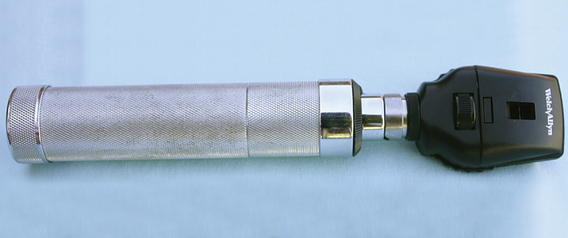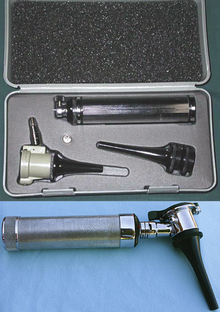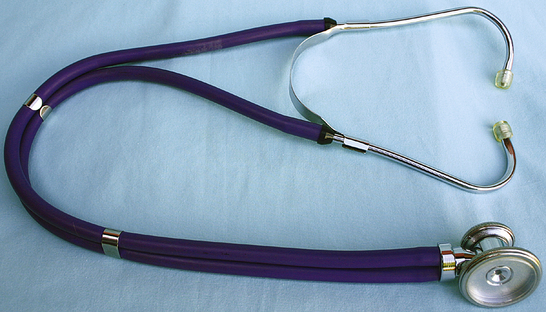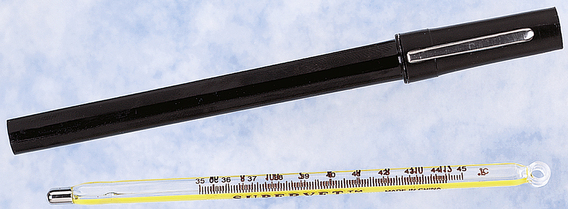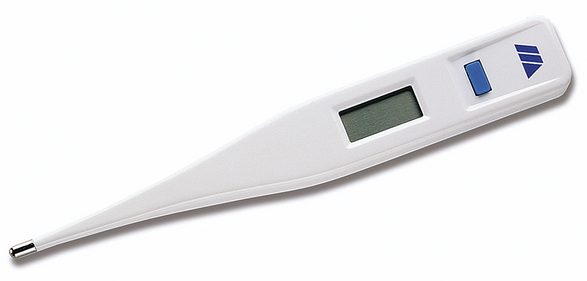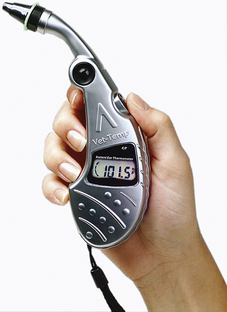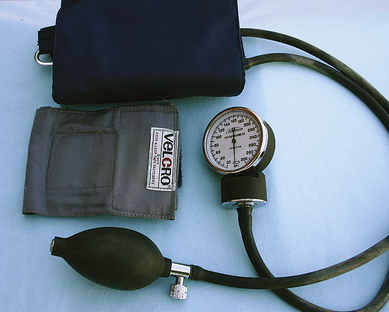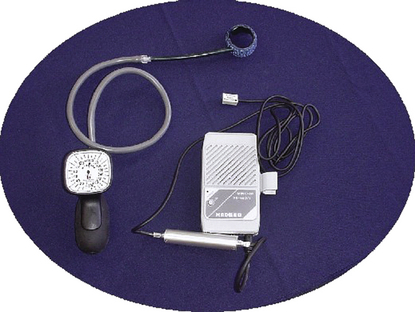CHAPTER 2 Diagnostic Instruments
This chapter covers instruments that assist in evaluating the health status of patients.
INSTRUMENT
Ophthalmoscope
| FUNCTION | To view the external and internal structures of the eyeball. |
| CHARACTERISTICS | The head of the ophthalmoscope has one dial that controls the amount and shape of the light and another dial that controls the depth of penetration. Many handles can be used interchangeably with an otoscope head. The handles can be battery operated or can be plugged in to be recharged. The user turns on the light by depressing the red button and turning the black dial. |
INSTRUMENT
Otoscope
| FUNCTION | To view the internal structures of the ear canal and eardrum. |
| CHARACTERISTICS | The head of an otoscope has a light source and cones of varying lengths and diameters that fit inside the ear canal. The cones can be changed by being slipped into the ring receptacle. To control the light, the user depresses the red button and turns the black dial. Many otoscopes have a magnifying glass to assist viewing. The otoscope can also be used to facilitate the catheterization of female dogs and cats. |
INSTRUMENT
Stethoscope
| FUNCTION | To ascultate the heart, lungs, and digestive organs. |
| CHARACTERISTICS | A head is equipped with a bell covered by a tight plastic membrane that is attached to a long rubber tube that ends in earpieces. The head can have two bells, one for adult animals and one for small or young animals. If the head has two bells, the user can engage one or the other by simply turning the head in a circular motion. |
INSTRUMENT
Thermometer: Mercury; Small and Large Animals
| FUNCTION | To determine the body temperature of an animal. |
| CHARACTERISTICS | A glass tube is filled with mercury and has graduations from 94° to 110° F on large-animal thermometers and 96° to 105° F on small-animal thermometers. The small-animal thermometer is usually 4 inches long; the large-animal thermometer is 5 inches long and is topped by a ring. The ring allows the user to attach a string and a clip that, in turn, is attached to the hair on the tail of a horse or cow. This prevents the thermometer from falling to the ground if the animal defecates. Both thermometers are inserted into the rectum for about 2 minutes to obtain an optimal reading. |
INSTRUMENT
Thermometer: Digital
| FUNCTION | To determine the body temperature of an animal. |
| CHARACTERISTICS | Housed in plastic and equipped with a small window that displays the temperature, this thermometer has a long skinny tip that can be inserted easily into the rectum. Most of these thermometers beep when they have achieved their readings. When compared with the reading of a glass thermometer, that of a digital thermometer can vary by a degree or two, so checking it against the reading of a glass thermometer is advisable. If a wide range of readings is found in an animal assumed to be healthy, the thermometer’s batteries may be low and should be replaced. |
INSTRUMENT
Thermometer: Aural (Vet Temp)
| FUNCTION | To determine the body temperature of an animal. |
| CHARACTERISTICS | An animal’s temperature is taken by placing a short probe into the ear canal. This method is fast and seems to be accurate. Again, the user should watch for signs that the batteries are getting low. |
INSTRUMENT
Sphygmomanometer
| FUNCTION | To determine blood pressure. |
| COMMON NAME | Blood Pressure Cuff |
| CHARACTERISTICS | A cuff is wrapped around the patient’s leg, then inflated by use of the bulb until no sounds can be heard from the dorsal pedal artery. The manometer is slowly released by opening the valve. The first sound heard is the systolic pressure number. When the sound becomes a pronounced beat, the number indicated is the diastolic pressure. The diastolic number is not as accurate as the systolic number because of the variance in examiners’ hearing. |
< div class='tao-gold-member'>
Only gold members can continue reading. Log In or Register to continue
Stay updated, free articles. Join our Telegram channel

Full access? Get Clinical Tree


